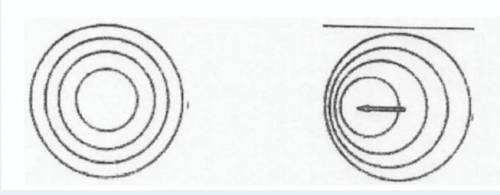
Physics, 06.03.2021 01:00, ashleymartinez147
Fig on the left shows a stationary source emitting the waves. Fig on the right shows the waves in the medium as the source starts moving towards the left. If you were an observer to the left of the source, what would you observe about the wavelength and the frequency of the waves?
A. Wavelength-Increase, Frequency-Decrease
B. Wavelength-Increase, Frequency-Increase
C. Wavelength-Decrease, Frequency-Increase
D. Wavelength-Decrease, Frequency-Decrease


Answers: 3
Other questions on the subject: Physics

Physics, 21.06.2019 15:30, jungcoochie101
What defines the mass number of an isotope? a. the sum of the neutrons and protons b. the sum of the neutrons and electrons c. the number of neutrons d. the number of protons
Answers: 1


Physics, 22.06.2019 00:30, powberier6979
Consider an ordinary, helium-filled party balloon with a volume of 2.2 ft3. the lifting force on the balloon due to the outside air is the net resultant of the pressure distribution exerted on the exterior surface of the balloon. using this fact, we can derive archimedes’ principle, namely that the upward force on the balloon is equal to the weight of the air displaced by the balloon. assuming that the balloon is at sea level, where the air density is 0.002377 slug/ft3, calculate the maximum weight that can be lifted by the balloon. note: the molecular weight of air is 28.8 and that of helium is 4.
Answers: 2

Physics, 22.06.2019 06:00, jagmeetcheema
The frequency of vibrations of a vibrating violin string is given by f = 1 2l t ρ where l is the length of the string, t is its tension, and ρ is its linear density.† (a) find the rate of change of the frequency with respect to the following. (i) the length (when t and ρ are constant) (ii) the tension (when l and ρ are constant) (iii) the linear density (when l and t are constant) (b) the pitch of a note (how high or low the note sounds) is determined by the frequency f. (the higher the frequency, the higher the pitch.) use the signs of the derivatives in part (a) to determine what happens to the pitch of a note for the following. (i) when the effective length of a string is decreased by placing a finger on the string so a shorter portion of the string vibrates df dl 0 and l is ⇒ f is ⇒ (ii) when the tension is increased by turning a tuning peg df dt 0 and t is ⇒ f is ⇒ (iii) when the linear density is increased by switching to another string df dρ 0 and ρ is ⇒ f is ⇒
Answers: 3
Do you know the correct answer?
Fig on the left shows a stationary source emitting the waves. Fig on the right shows the waves in th...
Questions in other subjects:



Mathematics, 12.01.2021 01:00


English, 12.01.2021 01:00


Mathematics, 12.01.2021 01:00

Mathematics, 12.01.2021 01:00


Mathematics, 12.01.2021 01:00






